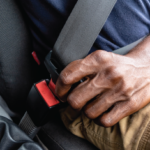On Sept. 9, my 5-year-old son boarded a bus for his first day of kindergarten.
In some senses, this was no different from any other year. We spent weeks trying to get him excited for school (he is not a fan of changes). We went to kindergarten orientation, toured his classroom and sat on his new bus to try it out. We scrutinized transportation plans.
On the morning of his first day, we gathered his school supplies, packed his backpack and put together a lunch of his favorite foods. He stood outside our house waiting for the bus and—much to our gratification—clapped his hands excitedly as it pulled up. After he boarded the bus without so much as a backward glance, we shared a tearful moment with a half-furious, half-despairing 2-year-old who was left home without his older brother for the first time in months. All of this was a veneer of normalcy.
But under that veneer, this year stood out from a normal first day of kindergarten. Along with his lunch and school supplies, his bag was packed full of clean masks and hand sanitizer. Boxes full of child-sized surgical masks wait at our door for him to take to school each day. Our towels now share a closet with a stockpile of home rapid antigen tests. When our son left that day, we had not seen his after-school program. No in-person orientation for adults would be held there. We had yet to meet his teachers in person and will not meet them, in all likelihood, any time soon. Pickup will be outdoors through the year; parents are barred from entering the school. The idea of seeing our child happily playing in his classroom is, at this point, a pipe dream.
In other words, we started a school year amid an ongoing global pandemic.
We are actually fortunate. Because our child was not yet school-aged last year, we were spared Zoom school and decisions about hybrid schedules. I don’t envy parents who were faced with that reality.
Nonetheless, the whole experience was shrouded in a deep sense of anxiety. This first day was occurring amid a wave of the Delta variant. Cases in our region had been flat, but the news was filled with coverage of schools in Florida, Alabama and Texas that had opened to tens of thousands of cases among children, including some deaths. For the first time, it wasn’t the risk to myself, my wife and elderly family that worried me. Almost everyone I know and love has now been vaccinated except our young children. Now it was my children at risk. This was different.
Although the risk of severe disease in children is low, it’s difficult not to worry about your child being one of the exceptions. Our district is taking reasonable measures to ensure safety, and our county vaccination rate is high, but it is impossible to shake that sense of anxiety. What if our child gets severely ill?
In constant combat with that anxiety is a coolly rational voice in the back of my mind. He’s young; his risk is low. Our local COVID-19 cases are still low. His teachers are vaccinated, and most of the other students’ parents are, based on our county’s vaccination rates. Anyway, surely, COVID-19 is not going anywhere. If he is likely to get it eventually, is it any worse for him to get it now rather than a few years from now? The benefit of school is well worth the tiny risk of a severe illness. … Right?
We are by no means alone in this. As I write this, today’s New York Times parenting newsletter is titled “Why COVID Has Broken Parents’ Sense of Risk.”1 In it, Jessica Grose perfectly describes the sense of numbness that comes from constant risk calculations. On trying to decide on a simple play date: “Well, let me just check the case rate in this ZIP code and multiply it by the number of pediatric hospitalizations, then subtract the loss of joy and normal socialization my child will undergo by missing out on yet another typical childhood experience.” It’s exhausting.
This summer has been a jarring flashback to the chaotic uncertainty of March and April 2020. For the first time in months, April through June 2021 were characterized by a sense of clarity. The world felt like it was once more expanding. But by summer 2021, we were back on the same unsettling ground that has characterized the past year of the pandemic.
This same uncertainty has been playing out in millions of households throughout the country, replicated across countless daily decisions, a fractal of small but taxing calculations. If each of these taxes us just a bit, the cognitive burden on the country writ large is colossal. I doubt I’m alone in saying this, but I am ready to stop thinking about this pandemic every day. But think we must because, at this point, we are still living in a situation in which society has forced decisions about a collective problem primarily to the individual level. So it’s worth asking: What, really, are the risks right now?
A Disclaimer
I think it’s worth taking a brief timeout before diving headfirst into COVID-19-related topics. First, I want to acknowledge that everything I’m about to address is in the context of the experience of the pandemic as it stands in the U.S. as of fall 2021. The reality is completely different in many low- and middle-income countries that still critically lack access to vaccination—an ongoing travesty perpetuated by wealthy countries like the U.S.—but that’s a topic for another column.
Even within the U.S., experiences are widely variable, with some states experiencing surges larger than even the peaks of winter 2020. I also do not want to discount by any means the impact that even low, ongoing levels of spread have on those who are most vulnerable in our society. Many of our patients, of course, fall into this category. In all of these situations, the weighing of risk is going to differ dramatically.
I also do not intend this to be prescriptive. From a public health standpoint, “Follow the science” clearly remains the right approach. But public health works on a policy level to nudge people in particular directions of behavior. The way people actually behave takes into account public health recommendations, but also their experiences, personal risk/benefit calculations and risk tolerance. The Centers for Disease Control and Prevention (CDC) warns against consuming uncooked dough, but this has never stopped me from choosing to eat cookie dough. It’s this aspect that I am hoping to discuss further, rather than imply that health policy should change around these more personal risk calculations.
Put differently, public health authorities can make decisions whether cases in my area are at a reasonable level to safely open schools. But it’s on me to decide whether to send my child to school, and if I do, whether I feel safe doing so.
Micromorts
Thinking about risk best starts from a simple acknowledgment that we are all going to die. In general practice, I’d say it’s worth reminding ourselves of this fact every now and then. Each action we take (or don’t take), pandemic or no, puts us one step closer to the grave. Talk to your friends about it. Trust me. It will make you popular at parties.
And yet, we don’t live our lives paralyzed by this fact. Decisions have to be made. Some feel normal, despite their inherent danger. Driving a car to work, for example, is probably the most dangerous activity a commuter engages in on most days, but we usually do it without a second thought. Other things may continue to strike terror in us, despite their exceedingly low risk. Who doesn’t occasionally experience that pit in their stomach worrying their plane is going to crash? And yet the likelihood of this is so exceedingly low, it’s a wonder it enters our consciousness.
It turns out that we humans are, in actuality, quite bad at risk assessment. We tend to make assessments of risk not based on numeracy, but on salience. Thus, although numerically far fewer people have died from terrorism in the past 20 years than automobile accidents, the salience of 9/11 still drives an extensive counterterrorism regime with wide public support. In contrast, we simply tend to accept that tens of thousands of people will die in automobile accidents annually. Indeed, as addressed in a prior Rheuminations column, people will actively advocate against measures meant to reduce this risk, such as seat belts.
Enter the concept of the micromort. Coined by Ronald A. Howard, a pioneer of the discipline of decision analysis, a micromort is defined as a unit of risk representing a one-in-a-million chance of death. It was intended to allow easier comparison of risks of death using a whole number rather than fractions with varying denominators.
The calculation is relatively simple: Take the number of deaths from a cause, divide by the number of days of exposure, then divide that result by the population exposed and multiply by a million. For example, ascending Mount Everest, which we intuitively view as a risky proposition, exposes the climber to 37,932 micromorts—over 1 micromort per foot of mountain. Driving a car 230 miles exposes the driver to approximately 1 micromort. Base (buildings, antennae, spans and earth) jumping has an exposure of 430 micromorts per jump—a risk similar to driving from New York City to Los Angeles 35 times.
For context, the U.S. baseline is approximately 1.6 micromorts per day for death from non-natural causes and about 22 per day for all causes.2 In the last normal season of viral infections, 2018–2019, the risk of death from influenza was about 0.3 micromorts per day.3 Being infected with COVID-19 in July 2020 likely exposed you to 10,000 micromorts (about enough to get you to Mount Everest base camp). Living in New York City in the height of its COVID-19 outbreak in March–June 2020 resulted in about 50 excess micromorts per day; similar to that of being a U.S. soldier in Afghanistan in 2010.4 Obviously, these values depend on many variables that change over time, for example the fatality rate of COVID-19 and underlying risk factors.
These days, I find myself constantly running through calculations like these in my mind.
What is the risk that I, personally, face as a vaccinated and relatively healthy young adult? Based on CDC data, between May 1, 2021 (when the CDC began collecting data on hospitalizations and deaths in vaccinated individuals), and Oct. 18, a total of 8,558 fully vaccinated patients died of breakthrough infections.5 As of Oct. 18, approximately 189 million people had been fully vaccinated in the U.S. Thus, the rate of death among this vaccinated population was 1 in 22,084, or 45 micromorts. Spread over the approximately 5.5 month time frame, this amounts to 0.25 micromorts per day.
Does the idea of base jumping make you nervous? Being unvaccinated sure should, as well.
What is the risk for the unvaccinated? In the same time period, from May 1 through Oct 18, a total of 159,806 deaths occurred due to COVID-19 in the U.S. Subtracting the deaths in vaccinated individuals, this leaves 148,949 deaths among unvaccinated, partially vaccinated or previously infected patients since May 2021. Assuming a U.S. population of 333,368,397 as of Sept 21, 2021, and 189 million fully vaccinated patients, this leaves 144,368,397 unvaccinated. This results in an exposure of 1,031 micromorts, or 6.03 micromorts per day for an unvaccinated individual in the U.S. between May and October 2021. Does the idea of BASE jumping make you nervous? Being unvaccinated sure should, as well.
What about children? In the same time period from May to October 2021, 281 children under the age of 18 died in 43 reporting states, Puerto Rico and Guam. The 2020 Census estimates a population of 73,106,000 children under 18 in the U.S.6 This amounts to an exposure of a total of 3.84 micromorts over a 171 day time period—or 0.02 micromorts per day—two orders of magnitude less than a 230-mile road trip.
There are admitted inaccuracies and omissions in these back-of-the-envelope calculations. Over time, the vaccination rate has changed, so the denominator is not actually constant over time. Rates of COVID-19 are likely underreported, especially in vaccinated individuals. Risk for COVID-19 deaths may rise in children with the opening of schools and increased exposures. “Mild” cases of COVID-19 may still result in substantial harms. And of course, for those of us who care about our friends, family, neighbors and patients, the very personal number of a micromort does not reflect the risk that someone else in your life may suffer. As the virus spreads, the risk that someone close to you dies is clearly far higher than the risk that one specific person dies. These limitations manage to deflate some of the cold comfort these values may bring.
Welcome to any given Tuesday morning in my head. Thinking about these risks is all a way, if nothing else, that I can keep myself sane with my unvaccinated son in school (although hopefully, not unvaccinated for much longer). The numbers help me rationalize. It’s enough mental gymnastics that it’s a wonder I haven’t pulled something.
Pandemic: Endgame
And so, when can I stop worrying? When will the mental gymnastics end?
My point here is not to engage in minimization of COVID-19 risk. Rather, it is to point out that what feels normal to us, in terms of risk of death, may actually already be close for those who are vaccinated. On a daily basis and without a second thought, a vaccinated individual engages in many activities that are associated with a higher risk for death than COVID-19—including driving to work.
What happens from here, I suspect, depends less upon the numbers and more on the salience of COVID-19. If it is truly defanged and hospitals cease to fill, people will likely cease to do these calculations in their heads, let go of the mental burden and return to life (nearly) as it was. Clearly, a segment of the population has already done just that—albeit prematurely, without safety measures in place and without, in many cases, the protection of a vaccine. If the pandemic maintains its salience through news stories and personal experiences of healthcare systems collapsing, a segment of the population is still likely to make the opposite decision.
Absent major advances, the endgame of the pandemic seems increasingly apparent. Stamping out COVID-19 entirely at this stage is likely to be a fruitless endeavor. The presence of breakthrough cases, carriage by vaccinated individuals and waning efficacy, especially against mild infections, raises a question of whether any plausible threshold of vaccination would lead to eradication of disease. Even Australia and New Zealand, among the countries best poised to potentially accomplish this lofty goal, have recently abandoned this endeavor.7,8
Rather, experts increasingly seem to be leaning toward a more likely scenario, that of endemicity—defanging COVID-19 through a combination of natural immunity and vaccinations. In this scenario, COVID-19 continues to circulate, still causing cases, but with progressively more mild illness that accords more closely with viruses that society accepts as a normal risk. In essence, it becomes yet another coronavirus that causes the common cold. In this scenario, the pandemic ends not with a bang but a whimper, a broad societal acquiescence to the virus. This has, after all, been the precise course of prior viral pandemics.
Justice Potter Stewart is oft quoted as saying of pornography, “I know it when I see it.”9 This is the way it is likely to go with the end of the pandemic. There will be no banners flying in the street, no parade, no V-J Day in Times Square moments. Rather, it will end with a critical mass of small lurches toward normalcy, made by each and every one of us, one small decision at a time. And eventually, enough of these small decisions will look just close enough to normal that it essentially will be. Each of us will do the risk calculi in our head and decide the benefits of normalcy outweigh the risks of the virus.
This fall, I sent my son to school.
 Ethan Craig, MD, MHS, is an assistant professor of clinical medicine with the Division of Rheumatology at the University of Pennsylvania, Philadelphia, and a rheumatologist at the Corporal Michael J. Crescenz VA Medical Center.
Ethan Craig, MD, MHS, is an assistant professor of clinical medicine with the Division of Rheumatology at the University of Pennsylvania, Philadelphia, and a rheumatologist at the Corporal Michael J. Crescenz VA Medical Center.
References
- Grose J. Why COVID has broken parents’ sense of risk. 2021 Sep 15. The New York Times.
- Micromort. Wikipedia.
- Estimated flu-related illnesses, medical visits, hospitalizations, and deaths in the United States—2018–2019 flu season. Centers for Disease Control and Prevention. Last reviewed: 2021 Sep 21.
- Roberts DC. Putting the risk of COVID-19 in perspective. The New York Times. 2020 Jun 3.
- COVID-19 vaccine breakthrough case investigation and reporting. Centers for Disease Control and Prevention. Last reviewed: 2021 Oct 15.
- Oguwole SU, Rabe MA, Roberts AW, Caplan Z. U.S. adult population grew faster than nation’s total population from 2010 to 2020. United States Census Bureau. 2021 Aug 12.
- Australia is ending its zero-COVID strategy. The Economist. 2021 Aug 28.
- Frost N. Battling Delta, New Zealand abandons its zero-COVID ambitions. The New York Times. 2021 Oct 16.
- Jacobellis v. Ohio. 378 US 184 (1964).
Editor’s note: Dr. Philip Seo is taking a writing break this month, and Dr. Ethan Craig, associate editor, stepped in to fill the void. Dr. Seo will be back next month.



